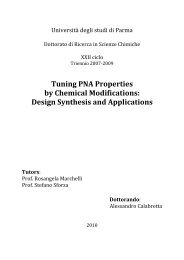Create successful ePaper yourself
Turn your PDF publications into a flip-book with our unique Google optimized e-Paper software.
dedicated to elemental analysis, and so no data are<br />
available concerning the exhaled biomarkers of effect<br />
and we were unable to detect pneumoproteins<br />
in EBC. However, we have further ongoing studies<br />
aimed at evaluating whether there is a correlation<br />
between elemental levels and biomarkers of effect in<br />
COPD.<br />
The few extreme data points that seem to distinguish<br />
different groups are unlikely to affect (influence)<br />
statistical differences, which have been calculated<br />
relying either on nonparametric tests (whose<br />
significance depends on ranks rather than on absolute<br />
values) or on parametric tests after log-transformation<br />
(necessary to obtain a normal distribution of<br />
data). In either cases, extreme values do not influence<br />
the statistical significance of observed differences.<br />
Our COPD patients were older than the subjects<br />
belonging to the other groups. However, age had a<br />
significant effect only on EBC iron levels (F 19.83,<br />
p 0.001). Differences between groups remained<br />
highly significant considering age as a covariate<br />
(F 20.44, p 0.001).<br />
Our CC16 data (the negative correlations between<br />
serum CC16 levels and smoking history, as well as<br />
EBC cadmium and lead levels) confirm that cigarette<br />
smoke reduces serum CC16 concentrations. 32<br />
The levels of this antiinflammatory protein returned<br />
to normal in the COPD patients who had stopped<br />
smoking (note the positive correlation between serum<br />
CC16 levels and the number of years as an<br />
ex-smoker).<br />
There is sufficient published evidence 35,36 to attribute<br />
the decrease in serum CC16 levels in smokers<br />
and COPD patients to chronic tobacco-induced<br />
damage to Clara cells. When renal function is normal<br />
or just slightly impaired (as in the volunteers we<br />
selected), serum CC-16 levels are only influenced by<br />
the intrapulmonary pool (eg, decreased in smokers)<br />
and the rate at which CC16 leaks into serum.<br />
No between-group differences were observed in<br />
SP-A and SP-B levels, but the SP-D results were<br />
interesting. It is particularly interesting to note the<br />
different SP-D levels in asthmatics and COPD patients<br />
because these may be clinically useful in<br />
distinguishing potentially overlapping diseases. Unlike<br />
serum CC16 levels, serum SP-D concentrations<br />
were higher in both smokers and COPD patients<br />
than in normal control subjects. This may be explained<br />
on the basis of the role of SP-D in local host<br />
defense, and our data are in line with the increased<br />
serum SP-D levels reported in patients with various<br />
lung diseases. 35 However, other plausible hypotheses<br />
concerning increased SP-D levels include increased<br />
lung epithelium permeability and increased surfactant<br />
degradation; although it has been demonstrated<br />
that SP-D is a “collectin” that is also found outside of<br />
the lungs and is therefore not an exclusively pulmonary<br />
marker. 37<br />
We conclude that EBC elemental analysis is a<br />
novel noninvasive approach to investigating lung<br />
pathobiology that is suitable for identifying the following:<br />
(1) the target tissue dose of carcinogenic and<br />
pneumotoxic substances from tobacco smoke and<br />
polluted workplaces or environments (cadmium,<br />
chromium, nickel, lead); and (2) the transition elements<br />
(manganese, copper, selenium, iron) involved<br />
in oxidative stress as part of redox systems. Together<br />
with biomarkers of effect such as serum pneumoproteins,<br />
the elemental composition of EBC may be<br />
clinically useful in distinguishing overlapping diseases.<br />
References<br />
1 Pauwels RA, Buist AS, Calverly PMA, et al. Global strategy<br />
for the diagnosis, management, and prevention of chronic<br />
obstructive pulmonary disease. Am J Respir Crit Care 2001;<br />
163:1256–1276<br />
2 Pellegrino R, Brusasco V. On the causes of lung hyperinflation<br />
during bronchoconstriction. Eur Respir J 1997; 10:468–<br />
475<br />
3 Baldi S, Miniati M, Bellina CR, et al. Relationship between<br />
extent of pulmonary emphysema by high resolution computed<br />
tomography and lung elastic recoil in patients with<br />
chronic obstructive pulmonary disease. Am J Respir Crit Care<br />
Med 2001; 164:585–589<br />
4 Saetta M, Turato G, Maestrelli P, et al. Cellular and structural<br />
bases of chronic obstructive pulmonary disease. Am J Respir<br />
Crit Care Med 2001; 163:1304–1309<br />
5 NRC (National Research Council). Biological markers in<br />
environmental health research. Environ Health Perspect<br />
1987; 74:1–19<br />
6 Kharitonov SA, Barnes PJ. Exhaled markers of pulmonary<br />
disease. Am J Respir Crit Care Med 2001; 163:1693–1722<br />
7 Mutlu GM, Garey KW, Robbins RA, et al. Collection and<br />
analysis of exhaled breath condensate in humans. Am J Respir<br />
Crit Care Med 2001; 164:731–737<br />
8 Rahman I, Biswas SK. Non-invasive biomarkers of oxidative<br />
stress: reproducibility and methodological issues. Redox Rep<br />
2004; 9:125–143<br />
9 Goldoni M, Catalani S, De Palma G et al. Exhaled breath<br />
condensate as a suitable matrix to assess lung dose and effects<br />
in workers exposed to cobalt and tungsten. Environ Health<br />
Perspect 2004; 112:1293–1298<br />
10 Kondo H, Nakagaki I, Sasaki S, et al. Mechanism of oxidative<br />
stress in skeletal muscle atrophied by immobilization. Am J<br />
Physiol 1993; 265:E839–E844<br />
11 Hermans C, Bernard A. Lung epithelium-specific proteins:<br />
characteristics and potential applications as markers. Am J<br />
Respir Crit Care Med 1999; 159:646–678<br />
12 Revised GINA guidelines 2002: Global initiative for asthma.<br />
Bethesda, MD: National Institutes of Health, National Heart,<br />
Lung and Blood Institute. NIH publication No. 02–3659<br />
2002<br />
13 Goldoni M, Caglieri A, Andreoli R, et al. Influence of<br />
condensation temperature on selected exhaled breath parameters.<br />
BMC Pulm Med 2005; 5:10<br />
14 Horvath I, Hunt J, Barnes PJ. Exhaled breath condensate:<br />
1296 Original Research<br />
Downloaded from<br />
chestjournals.org on May 23, 2007<br />
Copyright © 2006 by American College of Chest Physicians
















